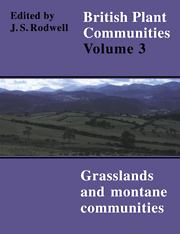Book contents
- Frontmatter
- Contents
- List of Figures
- Preface and Acknowledgements
- Preamble
- Mesotrophic Grasslands
- Community Descriptions
- Calcicolous Grasslands
- Community Descriptions
- Calcifugous Grasslands and Montane Communities
- Community Descriptions
- Index of Synonyms to Grasslands and Montane Communities
- Index of Species in Grasslands and Montane Communities
- Bibliography
Key to Mesotrophic Grasslands
Published online by Cambridge University Press: 04 July 2020
- Frontmatter
- Contents
- List of Figures
- Preface and Acknowledgements
- Preamble
- Mesotrophic Grasslands
- Community Descriptions
- Calcicolous Grasslands
- Community Descriptions
- Calcifugous Grasslands and Montane Communities
- Community Descriptions
- Index of Synonyms to Grasslands and Montane Communities
- Index of Species in Grasslands and Montane Communities
- Bibliography
Summary
With something as complex and variable as vegetation, no key can pretend to offer an infallible short cut to diagnosis. The following should therefore be seen as but a crude guide to identifying the types of mesotrophic grassland in the scheme and must always be used in conjunction with the data tables and community accounts. It relies on floristic (and, to a minor extent, physiognomic) features of the vegetation and demands a knowledge of the British flora and a few bryophytes. It does not make primary use of any habitat features, though these may provide a valuable confirmation of a diagnosis.
Because the major distinctions between the vegetation types in the classification are based on inter-standfrequency, the key works best when sufficient samples of similar composition are available to construct a constancy table. It is the frequency values in this (and, in some cases, the ranges of abundance) which are then subject to interrogation with the key. Many of the questions are dichotomous and notes are provided at particularly awkward choices or where confusing mosaics and zonations are likely to be found.
Samples should always be taken from homogeneous stands and be of 2 x 2 m or 4 x 4 m according to the scale of the vegetation or, where complex patterns occur, of identical size but irregular shape. Very small stands should be sampled in their entirety.
1 Coarse grasslands with frequent and often abun
dant Arrhenatherum elatius, Dactylis glomerata and Holcus lanatus. 2
These species usually occasional at most and rarely abundant in the sward 7
2 Deschampsia cespitosa present and usually codominant with Arrhenatherum and other coarse grasses but usually without large umbellifers
MG9 Holcus lanatus-Deschampsia cespitosa grassland
Arrhenatherum elatius sub-community
On ill-drained land from which grazing has been withdrawn, this vegetation type may grade to the Poa trivialis sub-community of the Holcus-Deschampsia grassland but Arrhenatherum and Dactylis become uncommon there and occasional Juncus effusus and Filipendula ulmaria appear with the increased frequency of Poa trivialis.
- Type
- Chapter
- Information
- British Plant Communities , pp. 26 - 30Publisher: Cambridge University PressPrint publication year: 1992

